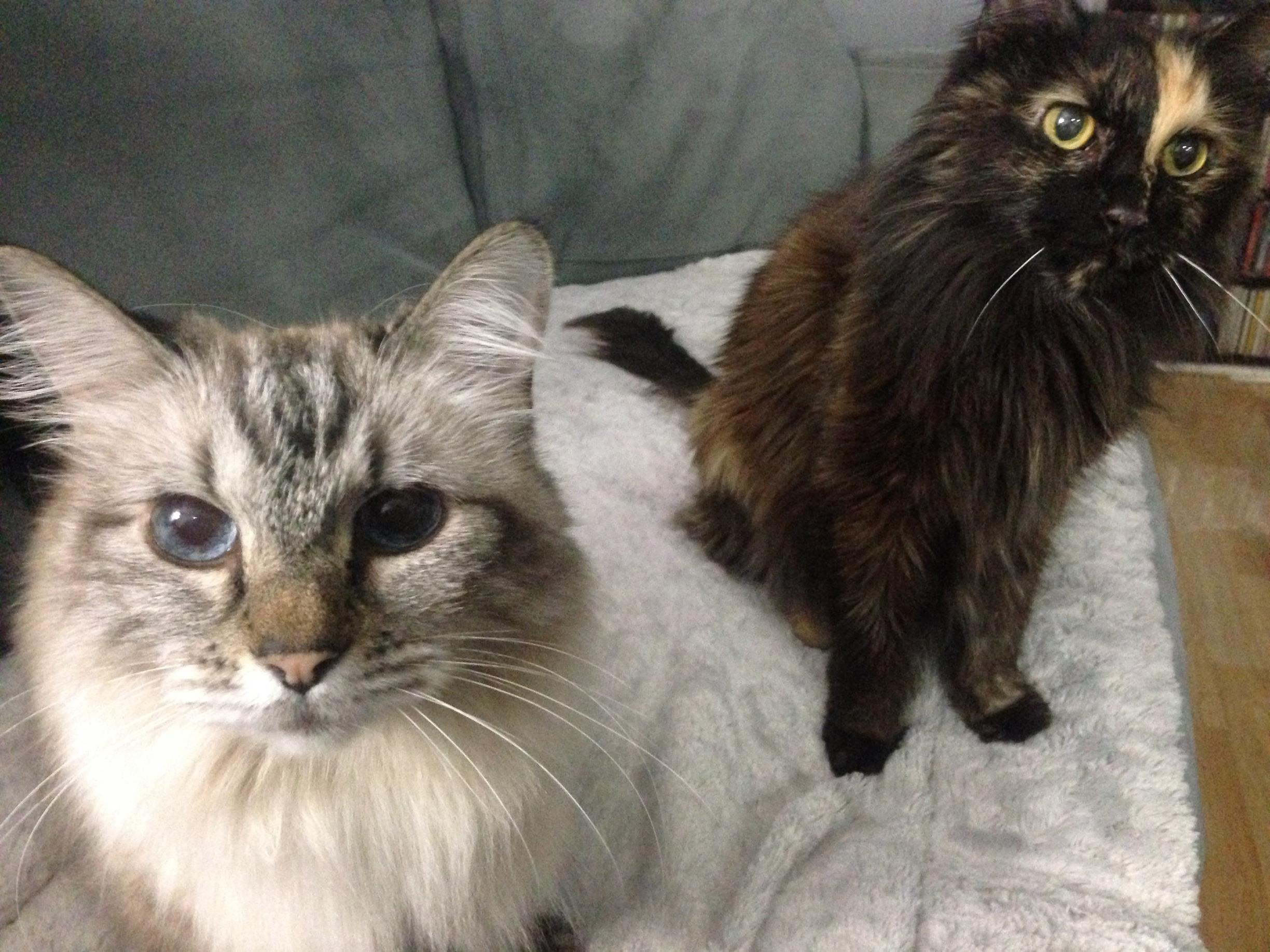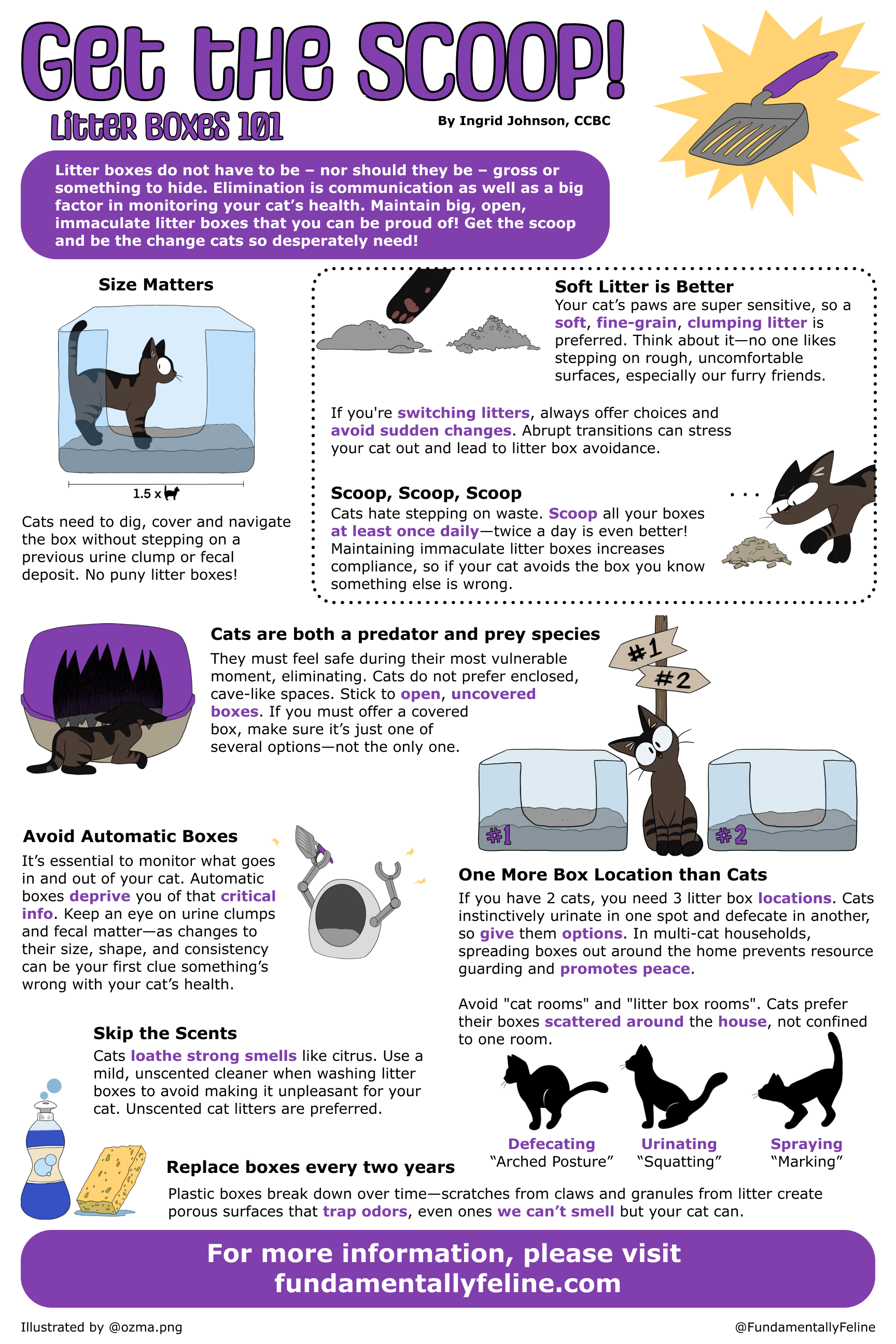
Get the Scoop! Litter Boxes 101-Infographic



Cats are trainable and can be quite easy to medicate. It is all about finding something that motivates them to make it worth their while. The key to this being successful is keeping the reward novel; do not burn them out on it. Humans struggle with this part. Be stingy with your rewards and before you know it your cat will be doing all kinds of tricks like sit, hi-five, and even riding a skateboard! Not to mention eating their pills willingly! That's right, just take a look at the photos below to see how my cats swarm me at meds time.
Meats:
Canned cat food-generally something different than you offer each day
Hill’s a/d, Royal Canin Recovery, Purina CN (these Rx diets are ultra hi-calorie and should only be used for medicating & positive reinforcement)
Single ingredient, plain meat human baby food (ham, chicken, beef, turkey) NO onions! Or try Ciao Churu purees (essentially baby food made just for cats) available in a variety of different flavors.
Broths-chicken and beef broth (low/no sodium), tuna, oyster or clam juice
Deli meat, boiled chicken, sardines, salmon, SPAM! (yes, Spam)
Dairy: *most cats are lactose intolerant-use sparingly*
Milk, cream, heavy whipping cream, whipped cream cheese, yogurt, vanilla ice cream, cheese (any version), squeeze cheese, sour cream, and the like
Outside the box ideas:
Mini marshmallows (they make a great pill pocket)
Banana or Peanut Butter




Traditional cat treats:
Freeze dried meat treats (Purebites-chicken & turkey or Halo’s Liv-a-littles)
Greenie’s dental treats or Greenie’s Smartbites
Temptations, Pounce, Whisker Lickin’s, Party Mix (considered junk food and a last resort for sick old seniors that need medications).
Any dry food other than their regular dry food can also be a treat.
*always check with your veterinarian first


Watch my Medicating Tips and Tricks video!
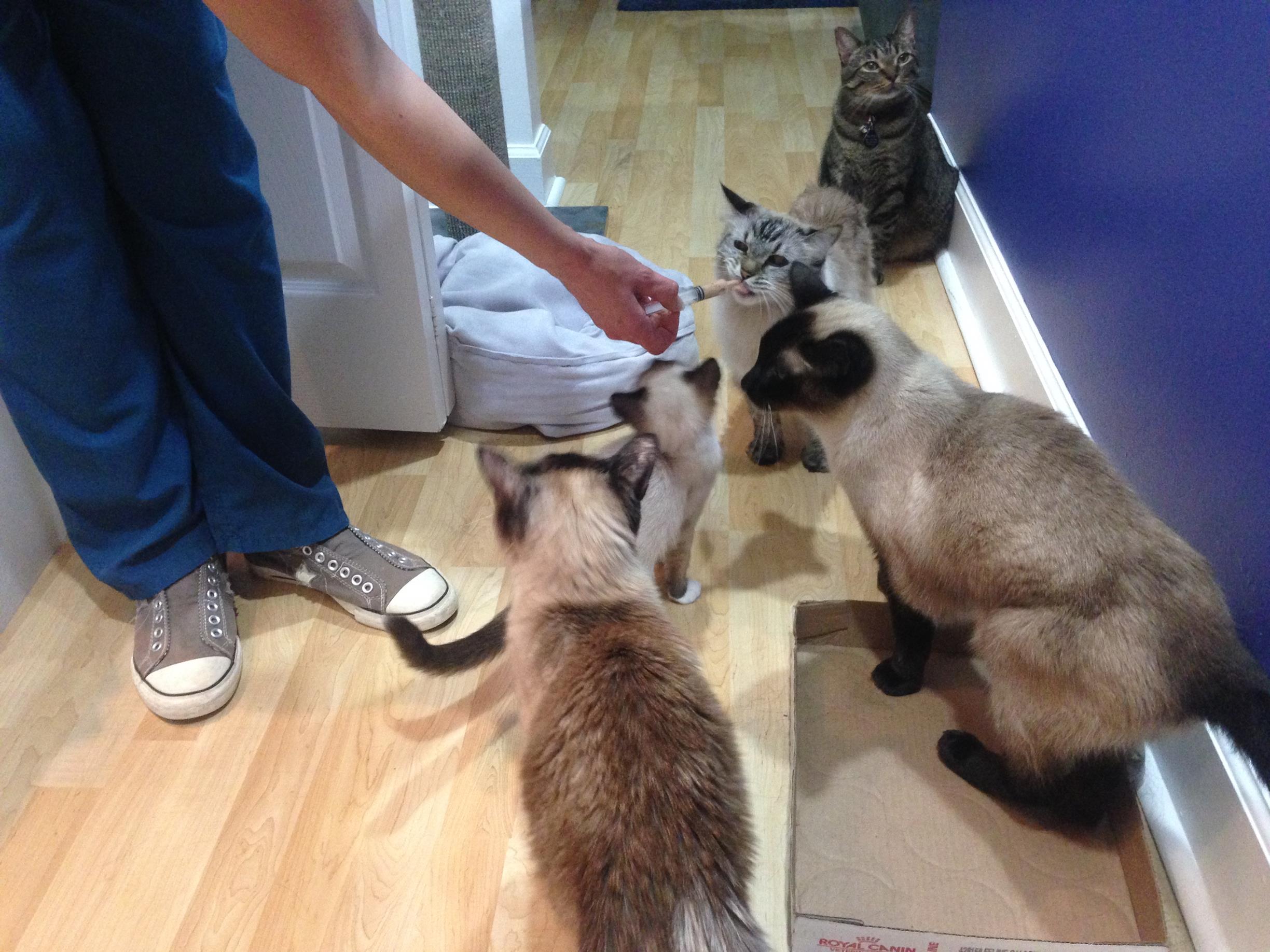
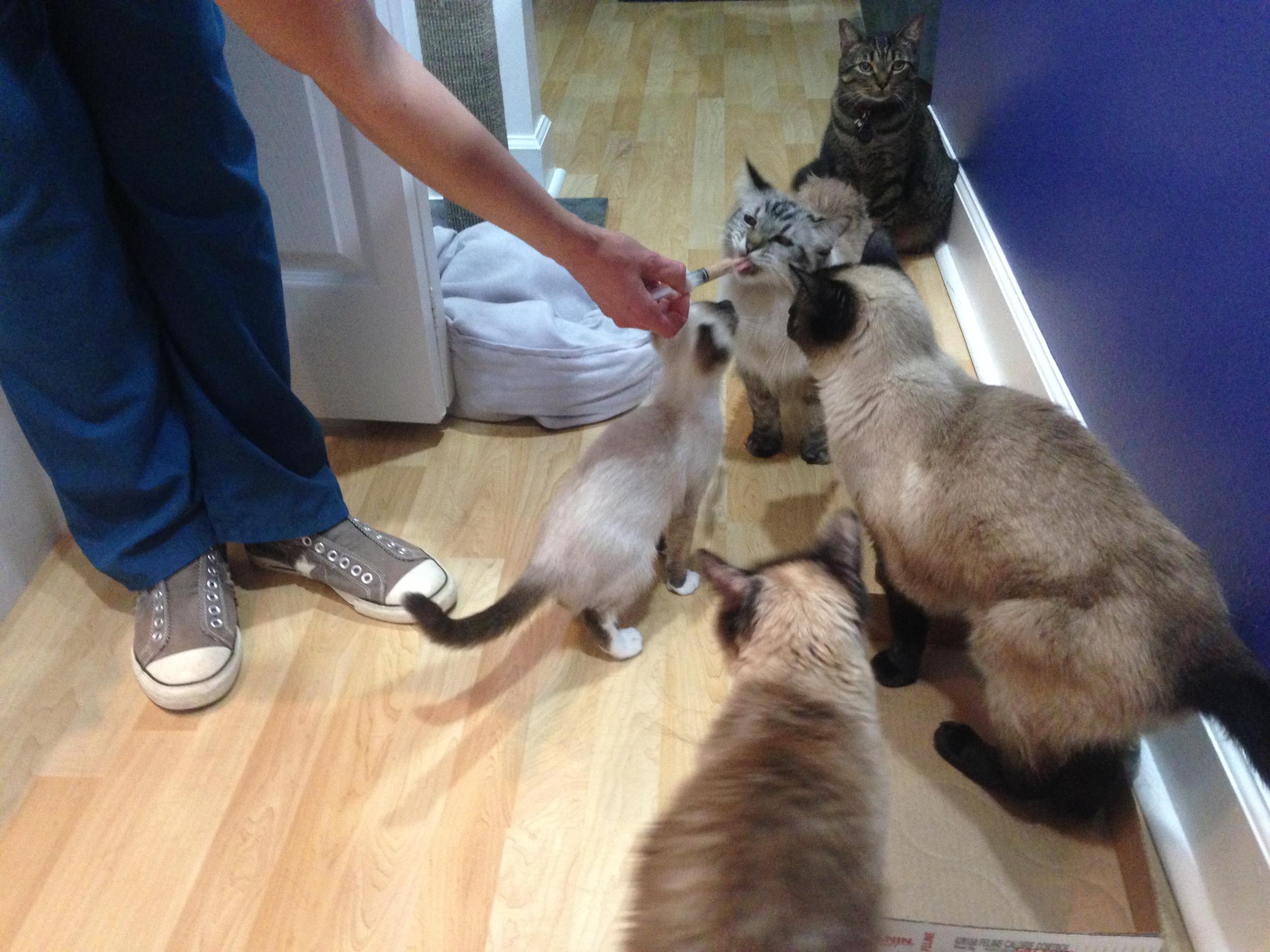
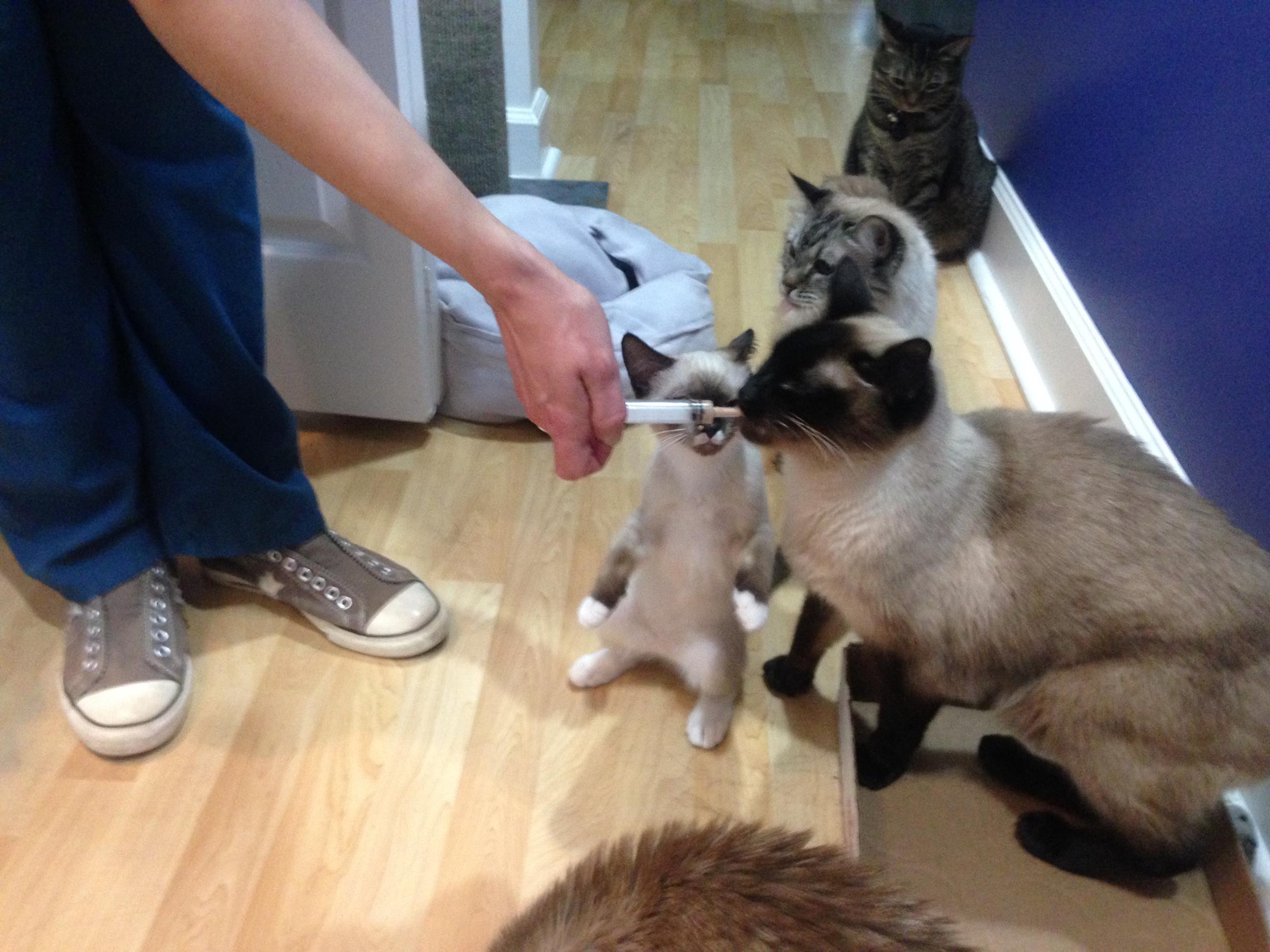
Taking your time with a slow, positive introduction process leads to long-term harmony.
The key to introducing cats to each other is to TAKE IT SLOWLY. Take little steps and evaluate how your cats react. There is no magic formula that will tell you when a cat is ready to be fully integrated into the household; you must be able to observe them and judge their progress on an individual basis. Some say their cats got along beautifully from day one (not that they should have even met that quickly), and others say it took six months or more before they finally lived peacefully under the same roof.
Cats can coexist together most of the time, even if they’re not the best of friends, as long as they are introduced slowly and positively and there are enough resources throughout the home. They should never be forced to share coveted basic needs such as food, water, litter, and perches.
During the introductory stage, you will probably notice that the original cats in your household are very curious about the other cat behind the door. (See “How to Introduce Cats to a New Environment” handout for details on how to set up your new cat’s safe room.) They will probably start sniffing under the door and maybe even hissing. Don’t be alarmed; it’s normal for cats to hiss at something new or something they don’t understand. Hissing is a distance-increasing behavior. Simply put, it’s a warning saying, “Please back off, and do not come any closer.”
We want to make sure the new cat and the old cat associate good things with that door and what’s on the other side of it. The following is a step-by-step guide on how to do that.
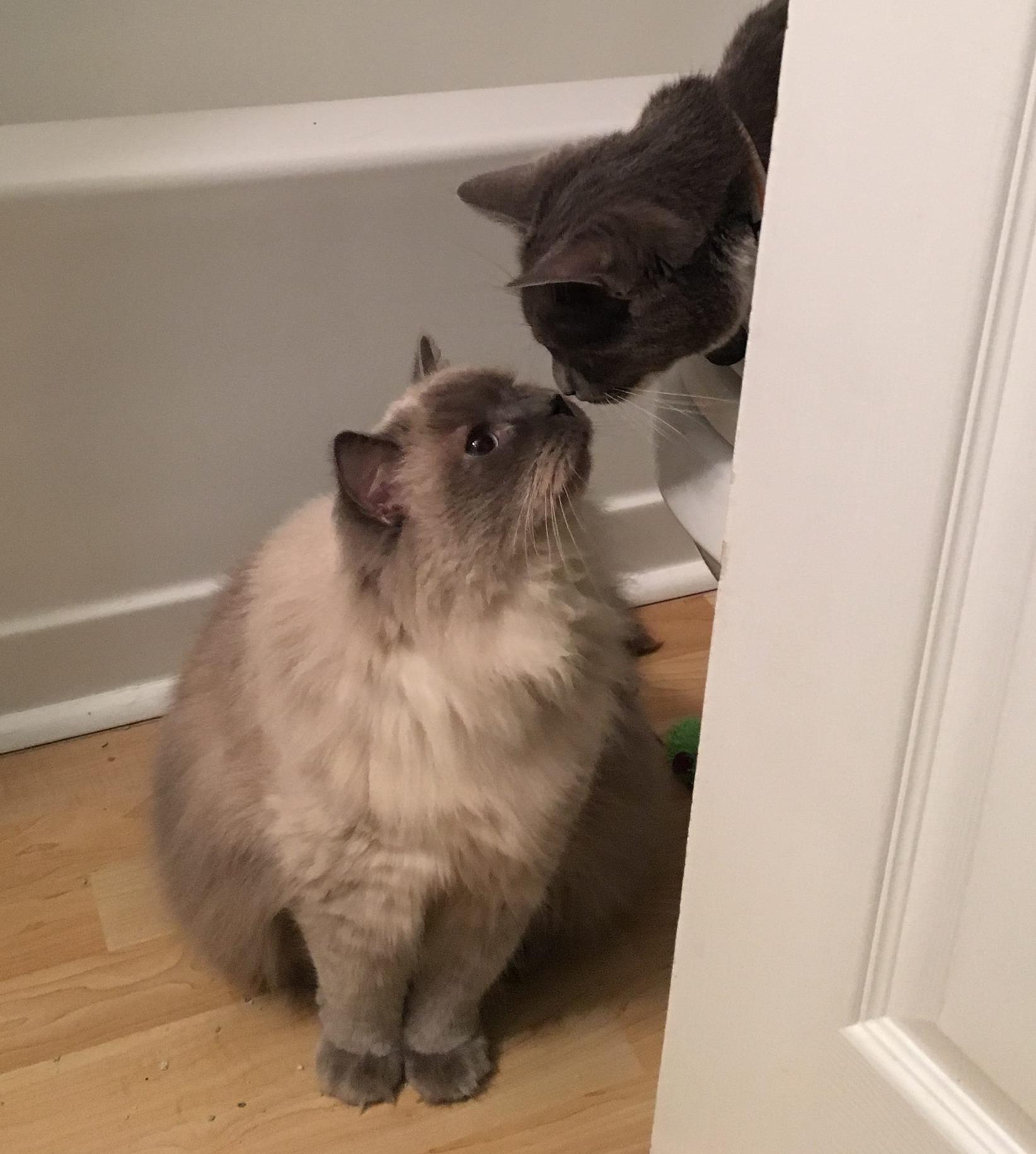
What Not to Do
Before we discuss how to properly introduce cats, we should touch on some techniques that are quite inappropriate but, sadly, often recommended:
These techniques are recipes for disaster!

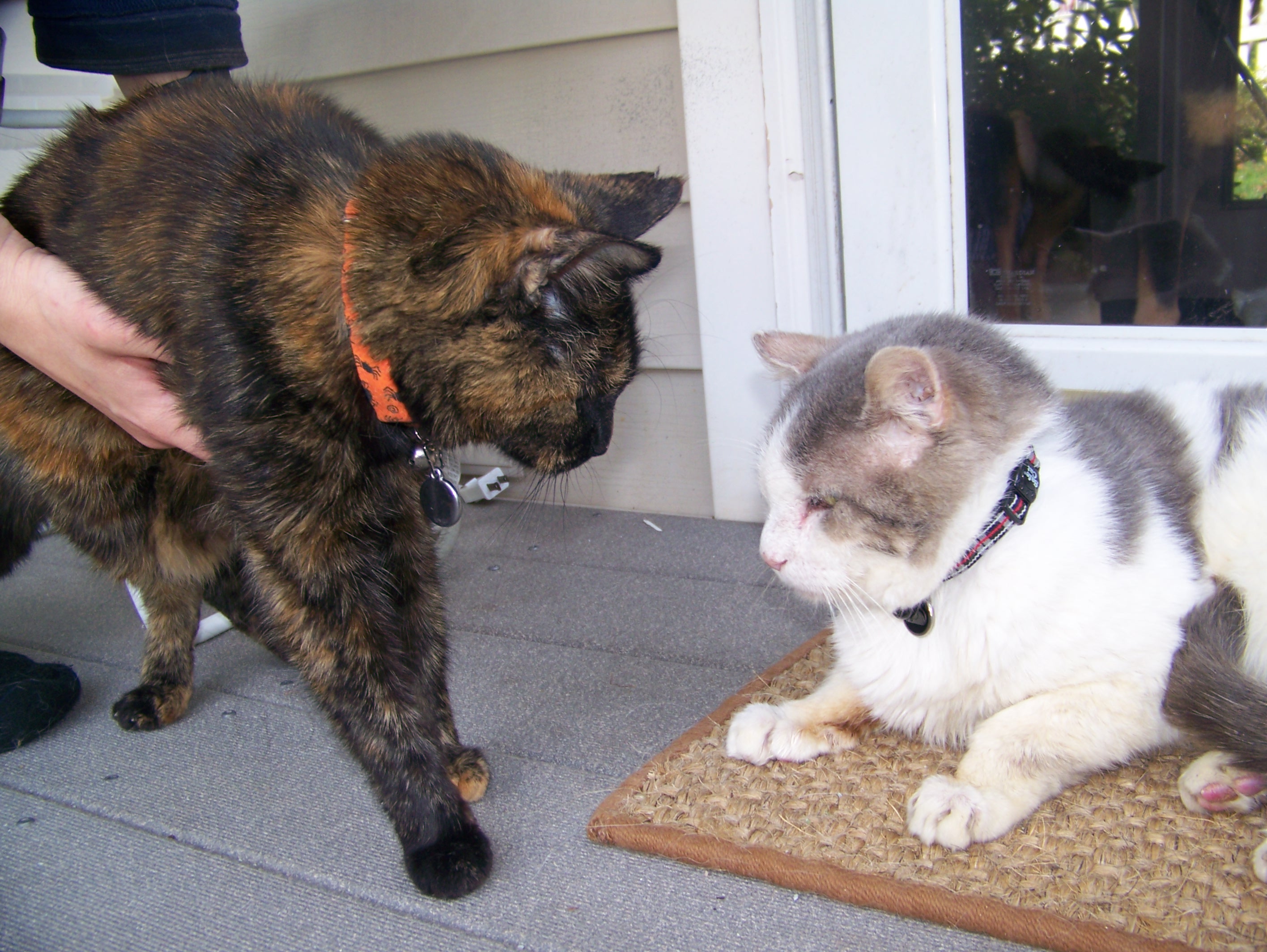
One Sense at a Time
Once the new cat(s) are eating, drinking, and eliminating normally, it is time to start the actual introduction process. It is best to introduce cats to each other one sense at a time.
Since cats are solitary predators and solitary eaters using their main meals as a means of introducing can be very stressful and could potentially result in associating anxiety and perceived competition in regard to the newcomer. For this reason, try interactive lure toys, brushing, or petting instead. Olfactory enrichment such as catnip, silvervine, valerian, and dried Tartarian honeysuckle can also be used. Use whatever each individual finds motivating. Using treats as rewards is perfectly fine, just avoid feeding their main meals together or having all food resources be near the new cat’s safe room. This is also a good time to mention that the cats do not need to be engaged in the same activity. One cat could be playing while the other cat is doing clicker training tricks or being brushed.

Cats who live together in a group form a colony odor or group scent. When bringing a new cat home, one of the biggest insults to existing cats is that the new cat smells funny, so we want to first facilitate scent exchange.
Some great ways to do scent exchanges are to flip-flop the bedding provided for each cat, swap their toys, and switch out their scratching posts every few days so they can cross scent mark each other’s posts without meeting. Wiping both parties down with a washcloth, old sock, or glove reserved for this purpose is also an excellent idea. If introducing one cat to multiple cats, work with individual scents to start, once that is going well, we can start to work with combination scent. Color code the items so you know which to use on whom. What we do not want to do is molest the cats with another cat’s scent! Simply rub the jowls, face, and head of one cat with the cloth and then lay it in the other cat’s space. This allows them to explore the other cat’s scent, hiss at it, rub on it, whatever they choose to do, but we should not rub that cloth all over the other cat’s body. Given the sensitivity of a cat’s sense of smell, this can be extremely insulting. Combination scent cloths should be rubbed on objects the cats regularly rub up against such as walls, chair legs, even the human’s legs. Once all cats are accepting these new smells and actively rubbing against the cloth or object it is time to move on to site swapping.
Some commercially available products have been created to help ease tension among cats. Lavender, honeysuckle, and valerian root extract are all scents that have been found to have a calming effect on cats. Essential oils can be toxic to cats if ingested, so offer them in a way that allows for the inhalant calming effects but does not allow them to lick or eat the product.
Feliway is another popular commercial feline product. It works by utilizing pheromones and is available in two formulas. The original Feliway formula mimics the feline facial pheromone, making cats feel as if they have already marked a certain surface as their own using the scent glands in their jowls. The new Feliway Multi formula uses the pheromone found in the mammary glands of nursing moms, which reassures kittens and helps them form a bond with their mother. The goal of this product is to strengthen the relationship or build a bond with cats in the home and make them recognize each other as a more cohesive group. Feliway is often used as a “quick fix,” but just like medications, it is not a stand-alone cure. You will get the best results when Feliway is used in conjunction with a behavior modification plan.
Visual Barrier
The next step in introducing a new cat is to create a visual barrier. Double-stacked baby gates are probably the most common item used for this purpose, but you can also use a screen door, French doors, or closet shelving that has been zip-tied together — get creative! Be sure that you have eliminated the cats’ perception that they can scale the gates by thumbtacking a pillowcase, sheet, towel, or similar obstruction to the doorframe. If they successfully get over the gate even once, it will be more and more difficult to deter them. It could result in a cat fight and many steps in the wrong direction.
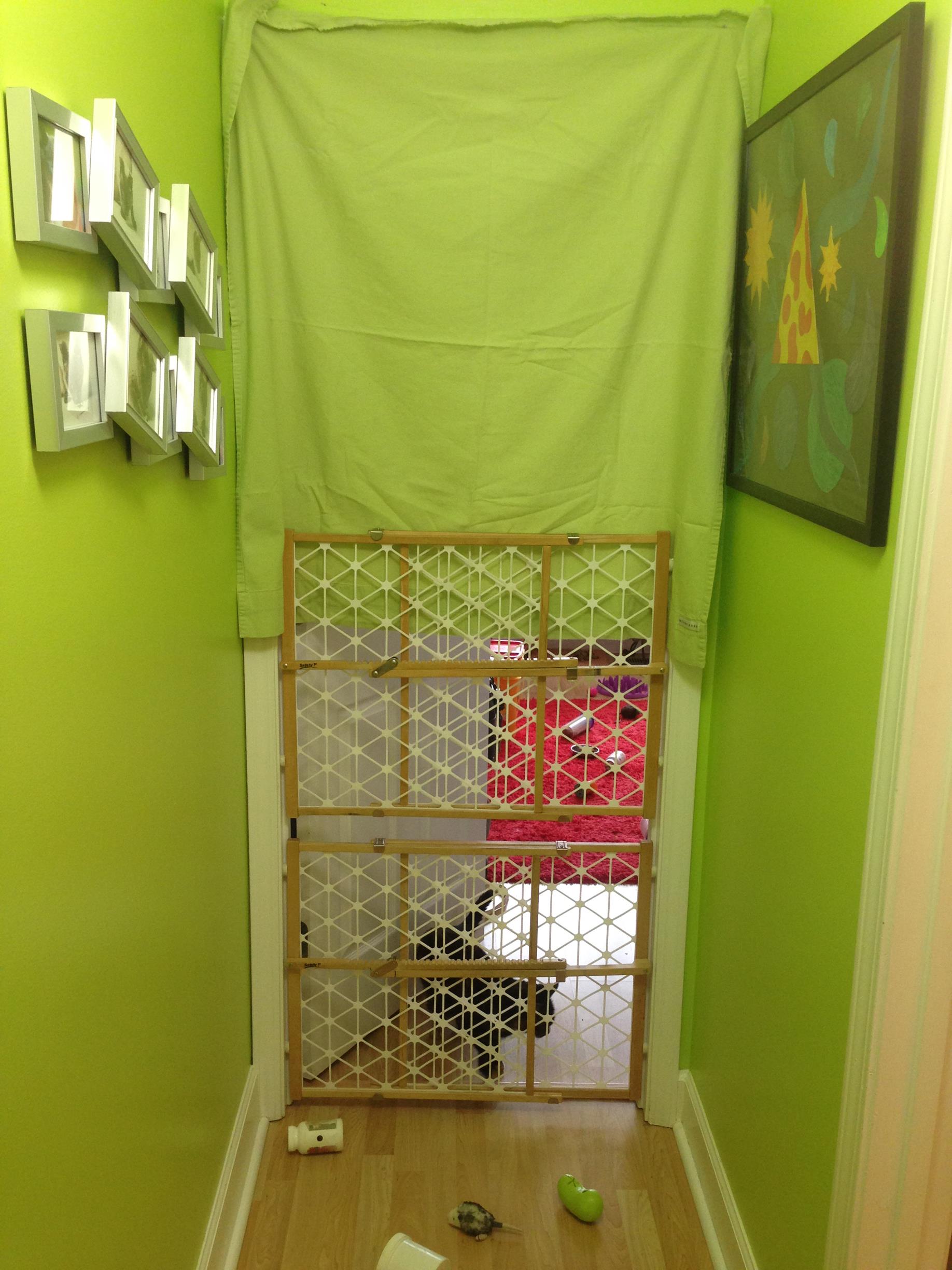
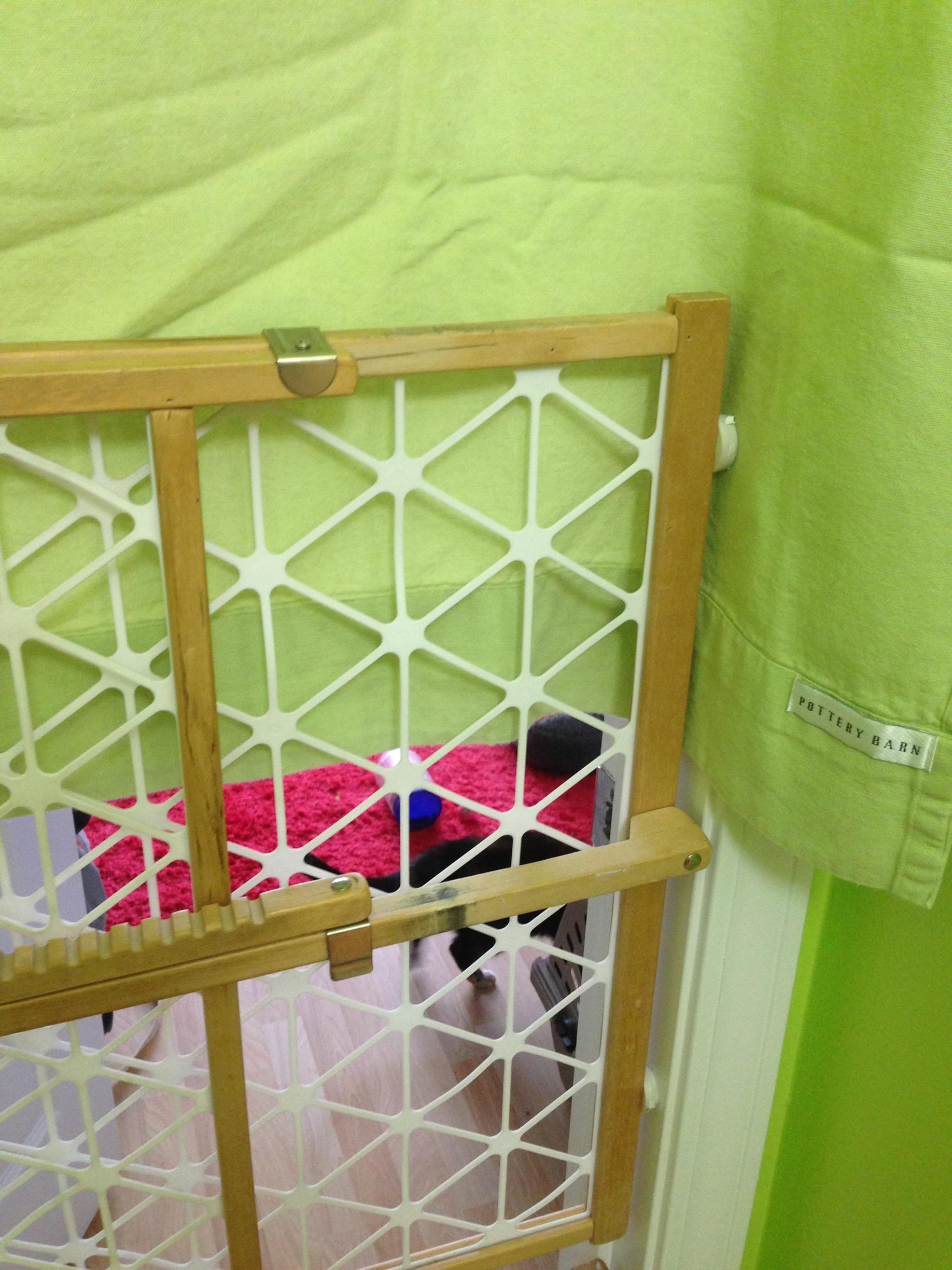
Once you’ve set up a visual barrier, repeat everything you did with the solid door, parallel play sessions at a distance, brushing, scent enrichment and treats. It is recommended to continue combination scent deposit throughout this process and on either side of the baby gates or doorways to achieve the greatest chance at scent recognition. This can be another use for Feliway, spray it on either side of the door frames and visual barrier.
During this phase, you may want to allow the cats to explore each other’s spaces. Put the existing cat(s) in a room they already enjoy, like the master bedroom. Allow the new cat to explore the home and get his or her bearings — while able to retreat to their safe room if they get spooked or overwhelmed. They can discover where food, water, and litter are located without the threat of bumping into one of the other cats. This exercise can build confidence. Each case is unique though. After successfully doing this a few times, you can allow the existing cat(s) into the new cat’s safe room to explore while the new cat has run of the house. This gives everyone a chance to hiss and spit and get their frustrations out without taking them out on each other.
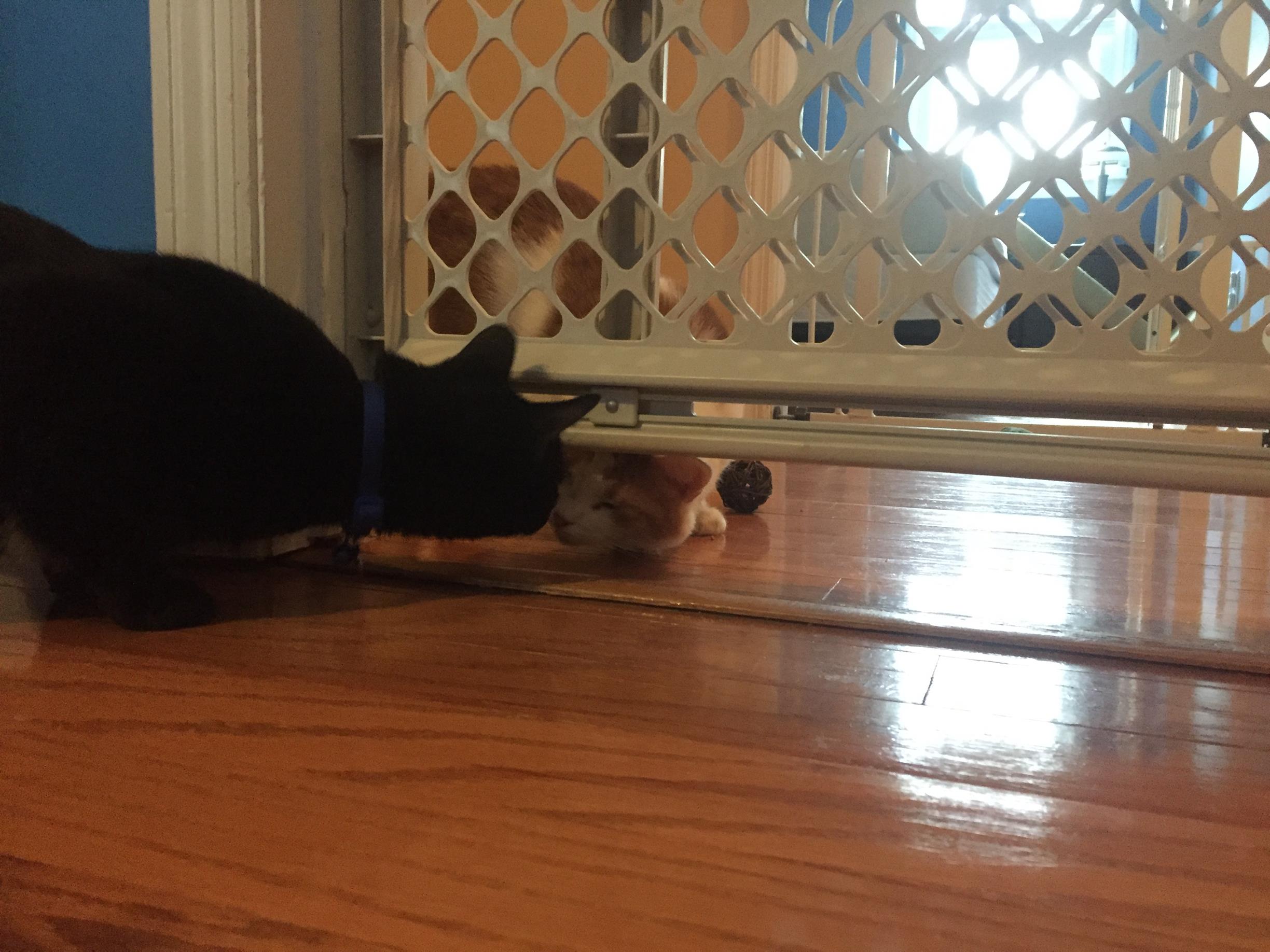

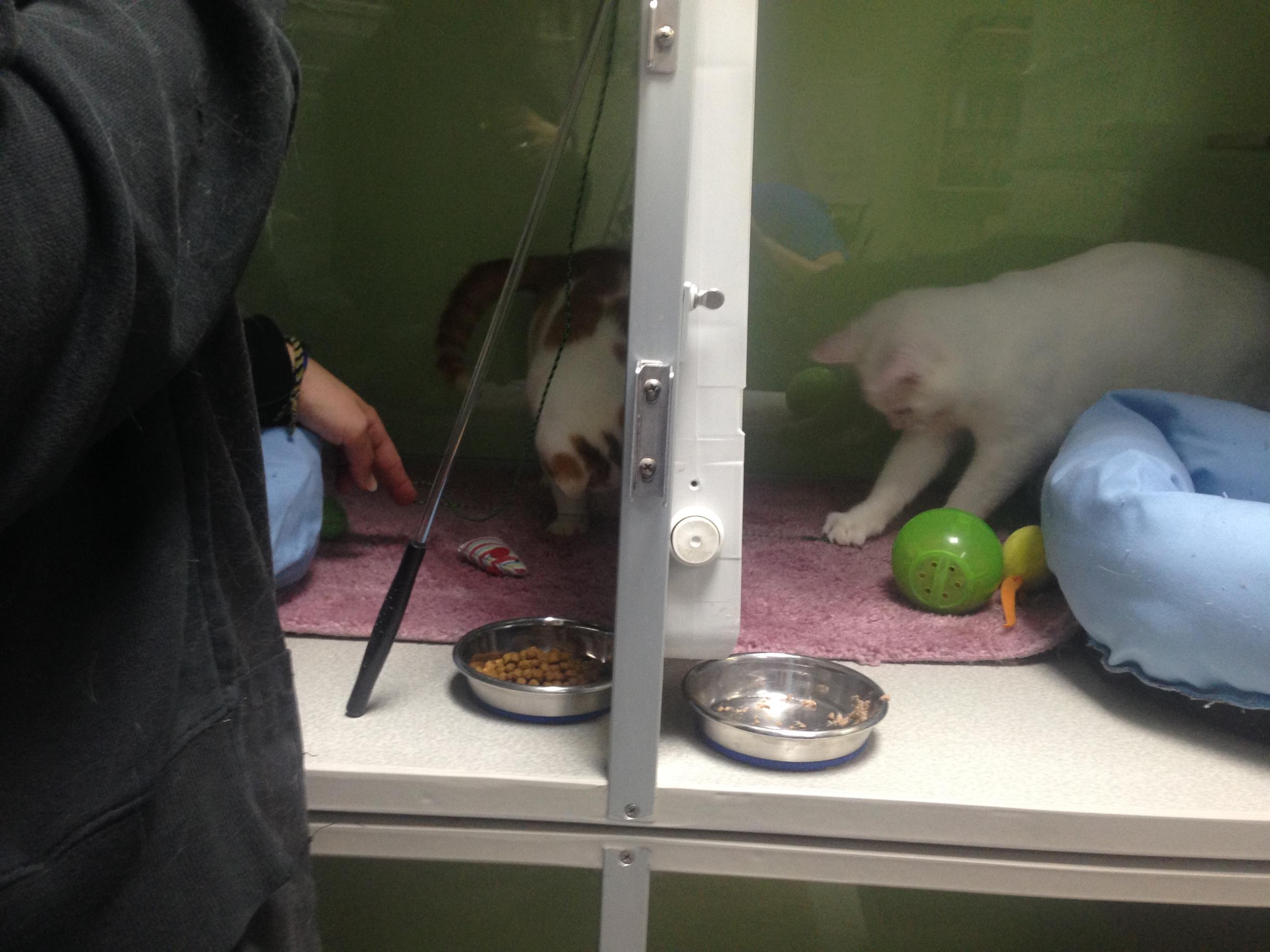
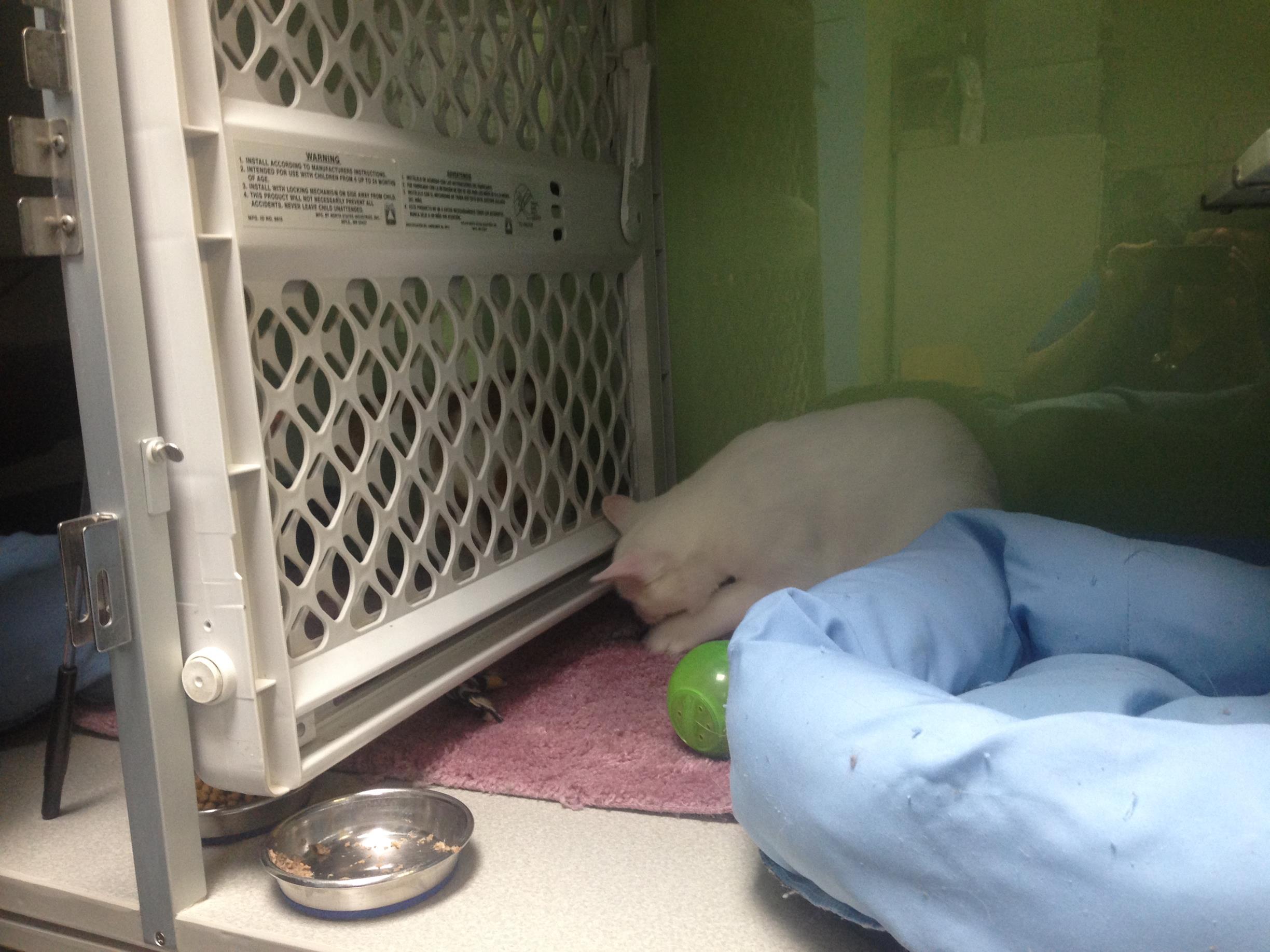

Taking a Step Back
Sometimes moving to a fully exposed visual barrier is simply too much for the cats, and we have to go even slower. This is especially true when re-introducing cats that have experienced redirected aggression. To do so, put up your visual barrier, but affix a piece of cardboard or poster board to the baby gate using twist ties. Cover gate to the bottom so they can only see about an inch of the other room (basically, all they can see is each other’s paws). This is more fool proof than a towel or sheet as persistent cats can slip behind the towel.
Additionally, target training, sometimes called mat training, can be a very helpful tool. Teaching the cats to target a mat and even do a few tricks on the mat can keep the cats engaged and focused on you, the human, and not so hyper focused or stressed by the other cat, new or existing. Then we use the mats as a tool to bring them within closer proximity to each other all while taking comfort in a learned activity that increases their confidence and keeps them focused.
Once mat trained this sets us up to play the “look” game. This game starts with the cats at the greatest distance you can, given your space. This could be 10 feet on either side of the visual barrier if your home allows for such distance. Gradually — every two or three sessions — bring the mats closer (about six inches to a foot at a time). As that goes smoothly, gradually increase visual sight by lifting the cardboard covering another inch. Continue this way as long as both parties are comfortable and staying focused on the game/reward. If they start to hiss, spit, or lunge at the visual barrier, move back to where you were previously successful for a few sessions. Do NOT move closer together or increase visual access if they are exhibiting these negative behaviors.
Similarly, if there comes a point when the more timid cat will not come any closer, try elevating him or her! Encourage the fearful cat to get up on a chair, footstool, or small cat condo. The height will make them feel more secure and in control. The mat training will help them know where you want them to go. Clicker training offers a language with which you and your cat can more effectively communicate.
Between sessions, DO NOT leave up the visual barriers and leave the cats unattended. This could result in terrible fights through the visual barrier and undo all of your progress. Close the door to the safe room between each session. Try to always end on a positive note.
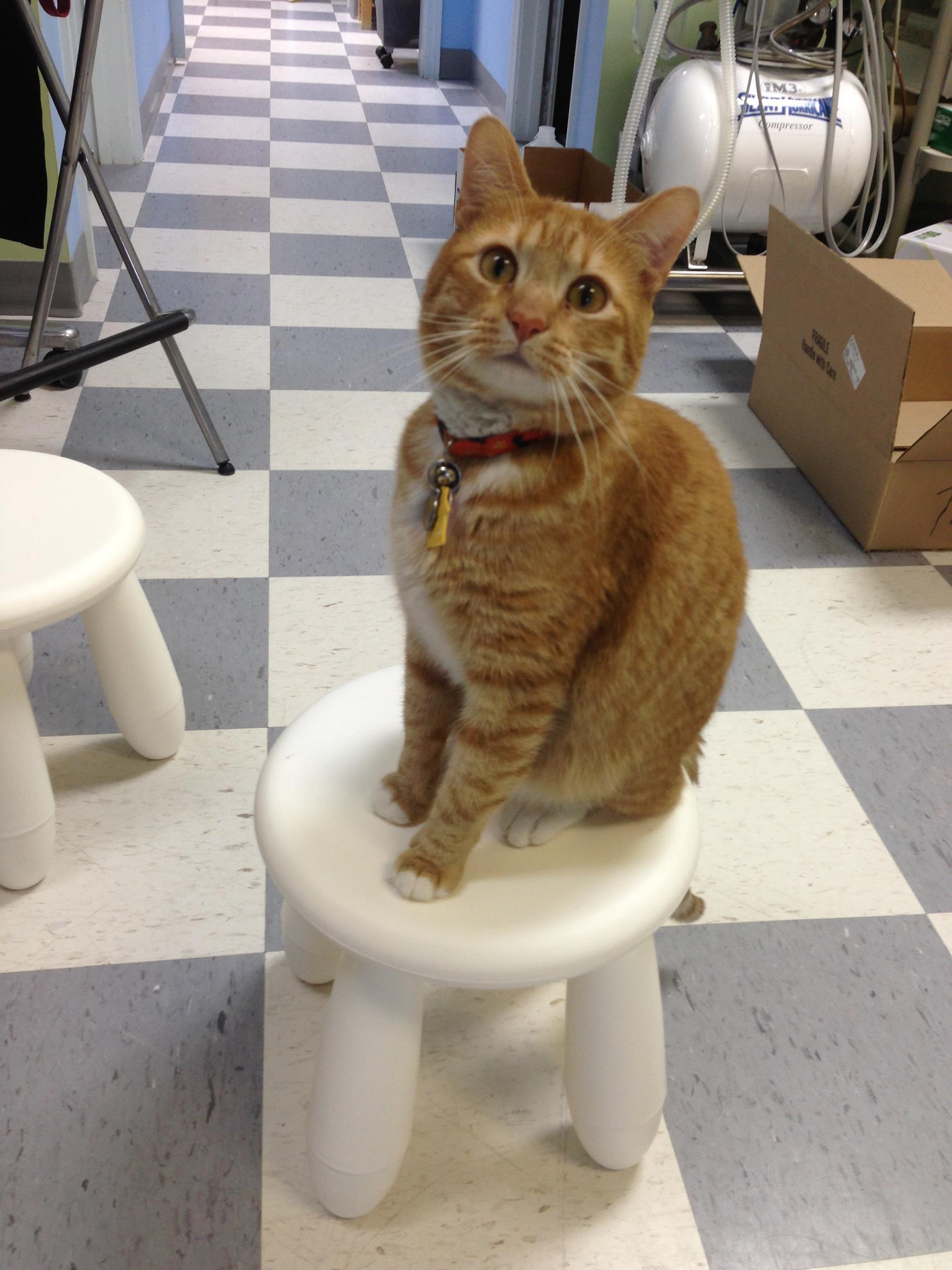

If you need some delicious training treat ideas here are some food rewards you can try:
The more you ask the more you pay so save high value food rewards for bigger asks!
Pattern games, as created by Leslie McDevitt, can provide similar focus as the mat training and the “look” game. What is a pattern game? Pattern games are a simple set of exercises that provide a predictable and secure structure for animals to help them normalize changes in their environment (potential "triggers" for reactive cats). Patterns are safe, predictable, repetitive, voluntary and normalizing! Once the pattern has been taught it would be utilized to keep the more aroused or unpredictable cat focused and under threshold so the other cat could build trust and not see them as a threat.

At the end of training sessions give an “all done” cue so your cats know they are done training. If simply using positive reinforcement and not the training techniques still keep the sessions short and positive. Close the door when you are done. These short, positive sessions should only take between two and five minutes in most cases. You want to leave them longing for the next time they see each other, because when they do, something good, fun, or delicious occurs. You are paying your cats to like each other!
The next step is to eliminate the barriers. Remember to not force anything. Work with the cats at a distance and slowly bring them closer together over time. This step could be really uneventful at first, which is exactly what we want. Allow the cats to approach one another at their own pace and continue using all of the tools that have worked so far: toys, treats, training and pattern games. Keep the sessions short and end positively. Gradually increase the amount of time they spend together, but keep them separated when you cannot supervise.
Overcoming Issues
What do you do if the fur flies despite all of this effort? Have lure toys readily available for positive distraction so that you can easily diffuse the situation. Be equipped with treats to shift their focus if need be. It’s helpful to have a large piece of cardboard on hand so you can quickly block them from seeing each other should their interactions become negative. Use this if they get into a spitting match, start to posture like they are going to charge each other (turning their bodies sideways to appear larger), etc. Remember, it is best to positively diffuse a squabble. Do not yell at or scold the cats; they are acting normally for them!
It is always best to interrupt the behavior and redirect onto an appropriate target. Interrupters should create a “yuck” response. If you make a loud sound, and they run and hide under the bed for three hours, you have instilled far too much fear. If, on the other hand, they think of the interrupter as a game, it is obviously not effective. You have to find just the thing that will make them stop in their tracks, think for a second about what they are doing, and then shift their focus onto an appropriate activity (usually an interactive toy). Some examples of good interrupters are clapping hands, whistling, a noisy plastic bag, or a shake can (you can put pennies in an empty soda can, or add nuts or bells to make it extra noisy). Note: Spray bottles are for plants and teach cats nothing. Their use is not recommended. Once you have successfully interrupted the squabble and shifted focus onto something appropriate, lure the new cat back to the safe room and end the session.
The feline ThunderShirt can also be used as an introduction tool. It can be especially helpful if you have a cat who is acting too aggressively or lunging at other cats. Once they become accustomed to the ThunderShirt, cats can freely move about while wearing it, but it does appear to inhibit their urge to lunge, jump, and even run. The concept of the shirt is similar to swaddling an infant — creating comfort and a calming effect by tightly wrapping them. The ThunderShirt can serve two purposes: (1) having a calming and humbling effect on the aggressor while inhibiting some of their aggressive displays and (2) building confidence in the opposing party by allowing the two cats to spend time together without the threat of attack.
Sometimes we may also need the assistance of psychopharmaceuticals, but we like to exhaust nutraceuticals first. Composure treats, made by Vetri-science, contain the active ingredient L-theanine, the same ingredient that causes green tea to have a calming effect on humans. Anxitane, made by Virbac Animal Health, contains the same ingredients in tablet form. Finally, there is Zylkene, made by Vetoquinol, a hydrolyzed milk protein derivative known for its calming effects. Be sure to consult a veterinarian about utilizing these and other medications.
Reminders for Multi-Cat Households
When you adopt a new furry friend, a cat is not all that you will be adding to the household. You’ll need more litter boxes too. The rule of thumb is one box location per cat plus an additional box (see “Litter Boxes Get the Scoop Part One, Part Two, and Part Three handout for more tips). You will also need more feeding stations, water bowls, scratching posts, beds, and cat condos. Even in a small apartment, you can make enough room for your cats by creating more vertical space.
With the techniques described here, you can successfully introduce new cats to existing ones. The moral is that we humans are far too anxious to “just see how they do,” but taking a little more time in the very beginning will help us achieve much more harmony in the long term.
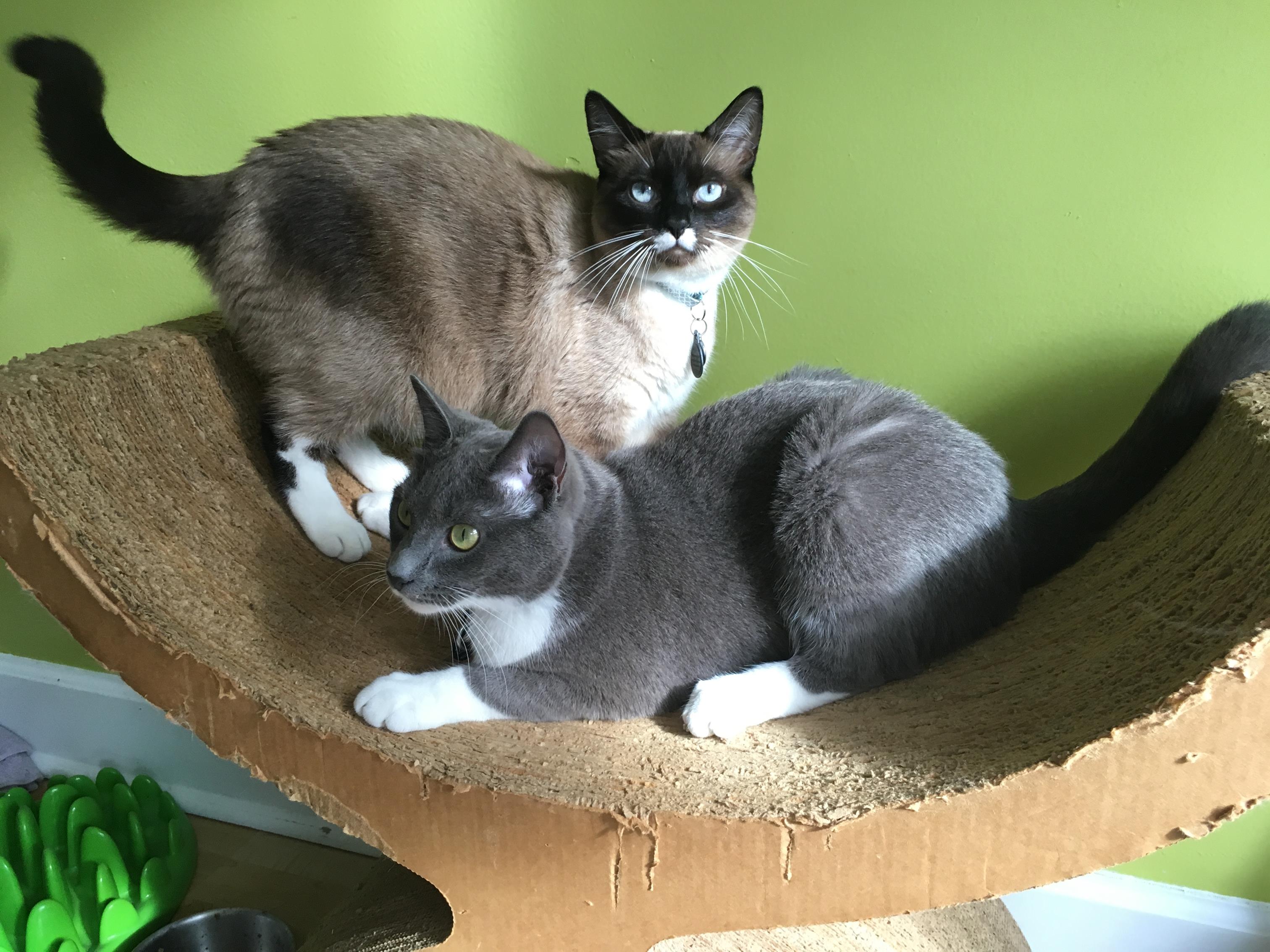
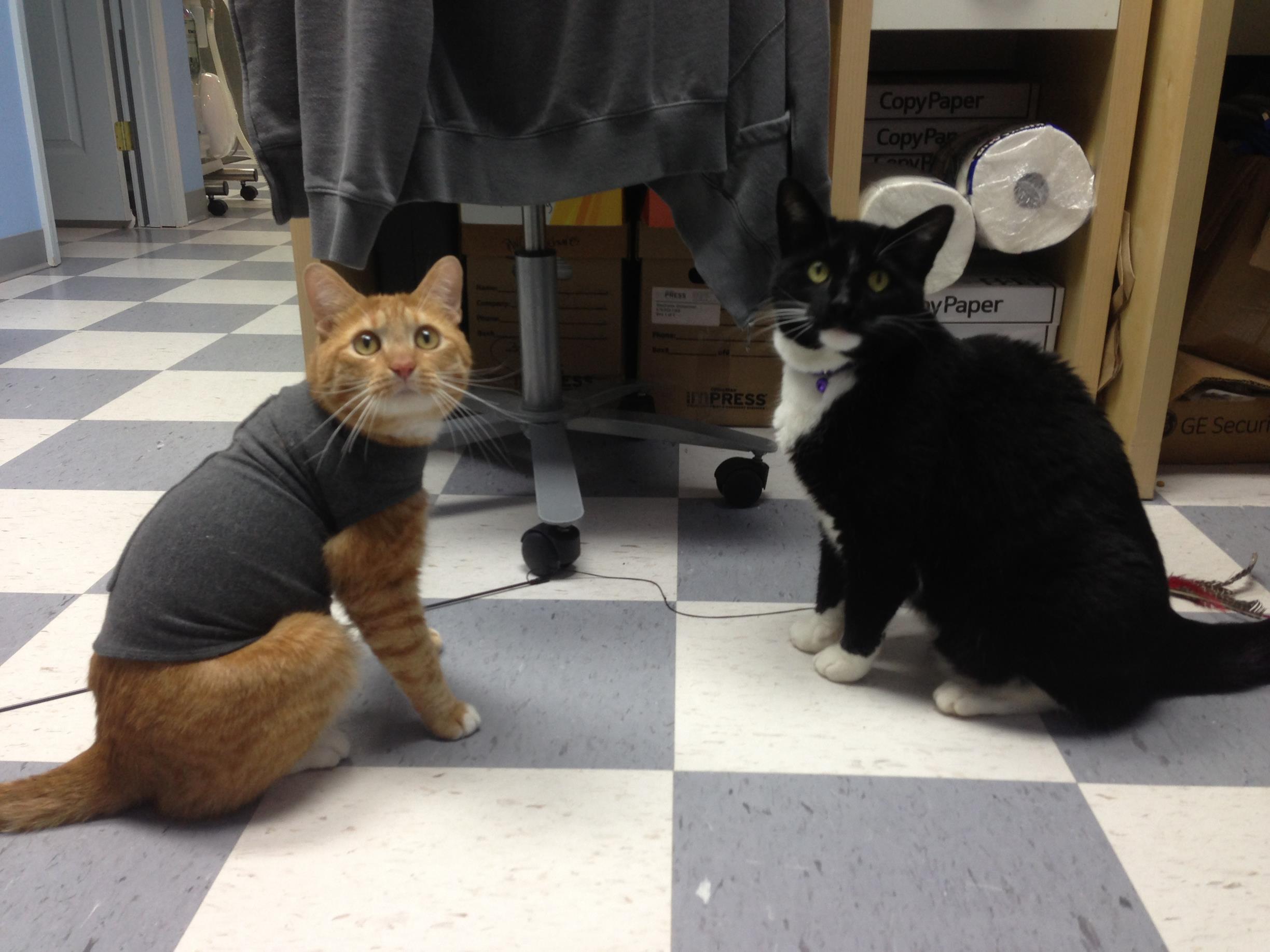
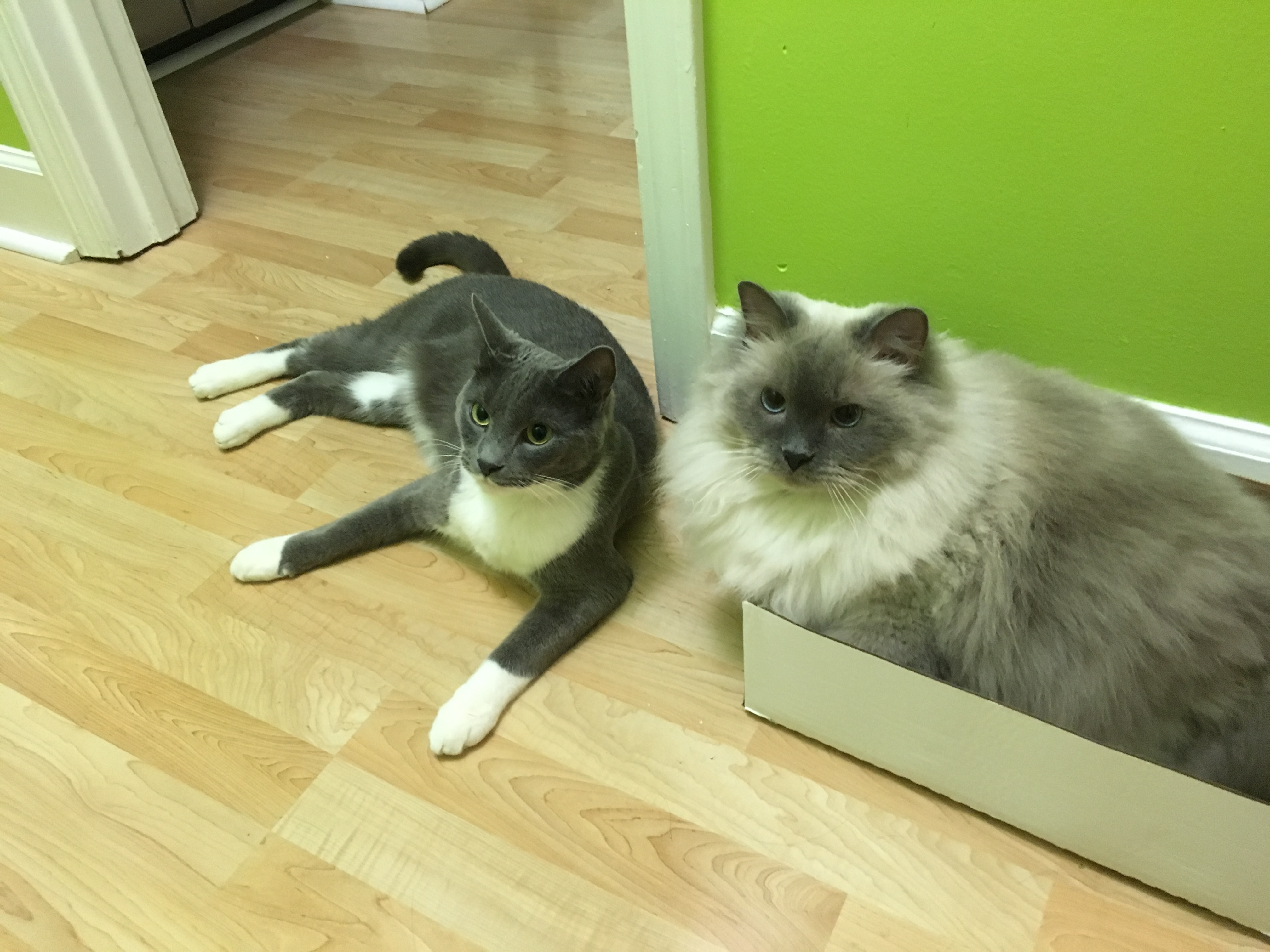
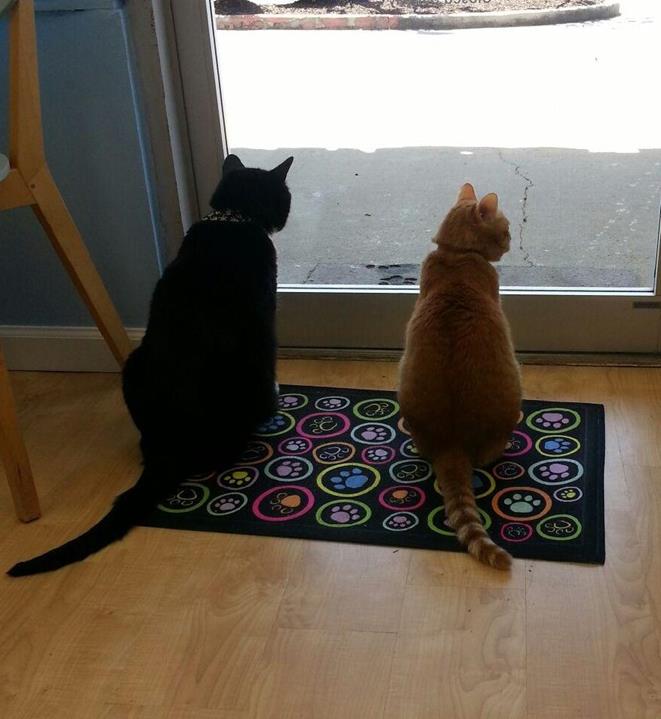
Helping a new cat get comfortable in your home involves much more than opening the carrier door.
Regardless of whether there are existing pets in the household, you should not give a new cat(s) the run of the house when you bring them home. Instead, create a safe room where they will remain until they tell us that they are ready to start exploring their new home and potentially meeting the existing cats.
Welcome home!
Their safe room should be a cozy area; cats feel comfort in small, confined spaces. Cats are both predator and prey, so when presenting them with a new environment, it is best to start small and allow them to acclimate slowly. This keeps them from feeling threatened and is especially important if the cat is shy or under-socialized. Hiding places should be available, and the cat should be allowed to come out at his or her own pace. Avoid using rooms where the cats can get under large pieces of furniture, such as beds, where you cannot access them, pet them, play with them, or offer treats and encouragement. This is especially important if the cat is timid.


Set them up in a room where you will be comfortable having resources (food, water, litter) long-term, potentially forever. Cats are creatures of habit and do not welcome abrupt change. Moving everything out of their safe room to suddenly convert it back into a guest room can be very stressful and result in unwanted behaviors such as eliminating where their litter box used to be or forgoing eating.
Make sure that all of the cat’s needs are met in the safe space. Set them up for success! Include at least one scratching post. This is your chance to start them off right, so if you adopted kittens, don’t offer puny kitten products! Give them the real thing that they would use as an adult cat.
If space allows, offer more than one litter box. Cats prefer to urinate in one area and defecate in another. Be sure to offer food, water, solo toys (so they can play when they feel safe and comfortable) and cozy, fuzzy beds. If they will be introduced to other cats, offer easily exchangeable bedding. We will use that later in the process (see our “How to Introduce Cats to Each Other” handout for more information).
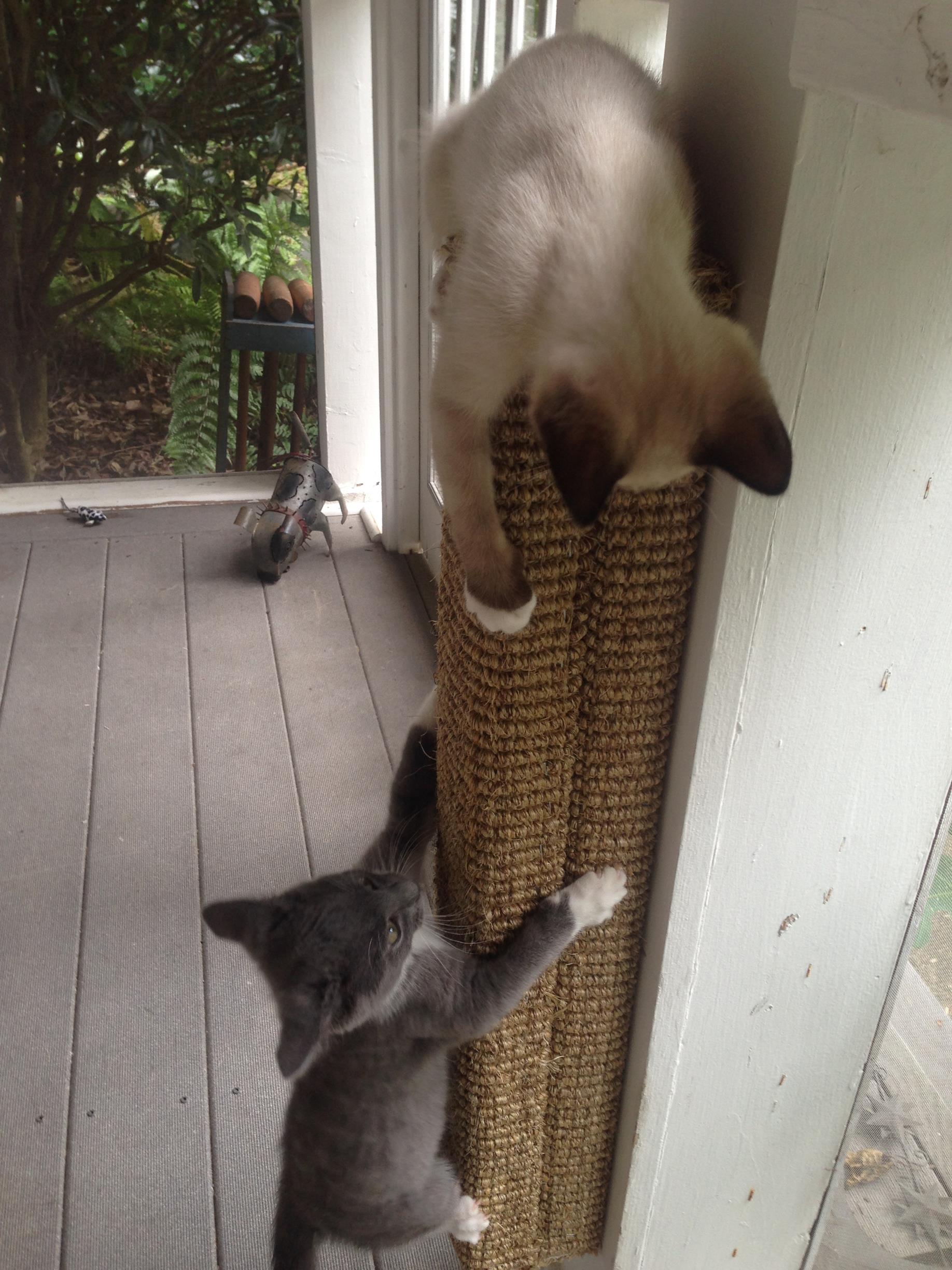
This safe room provides several advantages. It’s a place where your new cat can get used to you and other members of the household without feeling overwhelmed by the entire home. If there are other pets in the household, make sure they are not in the room to further intimidate your new cat while they’re exploring this strange new place. Also, as you begin to let the new cat out of the room and into the rest of the house, ensure they can return to their familiar safe place if they start feeling insecure or out of their comfort zone.
Safety Tips
Make sure the room, as well as the rest of the house, is “cat-proof.” Even if you already have cats who don’t chew on things like electrical cords, your new cat may find them fascinating and can get seriously injured or worse while playing. Also check for strings, ribbons, and small objects that can be swallowed, possibly leading to emergency surgery or even a fatality. Be sure that holes in walls, A/C vents, and ducts are all secured. You will be surprised what a scared cat can fit into!
Be sure your new cat is microchipped and start acclimating them to wearing a collar. You never know if you will have an emergency like a break-in or house fire. Be prepared! The best form of ID, should your new cat escape from the home, is a safe cat break-away collar with a microchip as a back-up if the collar comes off.
Acclimating to the Safe Room
When you bring your new cat home, immediately put them in the safe room with the door closed. Open the carrier and let them come out on their own. If there are other animals in the house, it is imperative that you do not set the cat carrier down and allow the existing animals to approach. This is threatening and frightening to the cat trapped in the carrier!
Initially, they may be shy or frightened and may find a place where they can gather themselves and feel safe before checking things out. Cats feel safe either under things (beds, couches) or up high (cat condos, dressers, cabinets). Eventually, they will begin exploring their new digs, often at night when it is dark. Offer nightlights in the safe room. A cat’s vision is at its best in low, dim light.
Over the next few days, make sure the cat is eating well and using the litter box. Any kind of change can be stressful to a cat, and moving to a new home is one of the most stressful events your cat will encounter. Because of this, it is not uncommon for cats to break with a cold or other illness after moving to a new home. Call your veterinarian immediately if you notice signs of illness.
Once the new cat is eating, drinking, and eliminating normally, it is time to start the introduction process to the rest of the home and/or to the other pets. You will know they are ready when they are eager to see you when you enter the room and curious about what is on the other side of the door. If they are still frozen with fear and hiding, it is not time to move forward to give them even more space. They will only feel more overwhelmed.
You will have the rest of your lives together. DO NOT rush or force things, as humans tend to do. Even when we think we are taking things slow, it is never slow enough for a cat!
Exploring the House
You may simply open the door so that your new cat can exit the room and retreat back to the safe room if needed. DO NOT force them to exit their safe room. Some cats will be perfectly content in this new room for weeks. Others will be eager to explore. Always go at your cat’s pace.
Place resources throughout the home, so as your new cat peruses the place, they learn where other sources of food, water, litter, and scratching posts are located. Use food, treats, and interactive lure toys to make the exploration a positive and fun experience!
Allow them to cruise around the home for 15 to 30 minutes, but confine them again at their next mealtime or before they get overwhelmed. You want to ensure that each exploration session ends on a positive note, not something scary that causes them to bolt around the house! It is also great to lure them back into their safe room using an interactive toy. This way, they actually go back in of their own free will and you have not “locked them up.”
Gradually increase the amount of time they are allowed outside of their safe room, eventually only putting them back in when you cannot supervise (in bed, at work). Depending on the individual cat or kitten’s needs, most will be able to enjoy the run of the house within a few weeks.
For more timid individuals, you may start by placing a baby gate across the doorway threshold before opening the door all the way. They may feel more inclined to approach the threshold with this “visual barrier” in place. You can then feed them their meals at this visual barrier, eventually removing it and feeding them in the open doorway threshold. You can utilize food or play to encourage them to take a few steps out of the room. Play increases confidence and decreases stress. Use this tool to your advantage. They may only come two feet out of the room before retreating back, but that is okay! Use play to lure them out of the room AND back in to increase their confidence to cross the threshold.
By taking things slowly and using the techniques described here, your new cat will grow to feel comfortable and confident in their new home.


More Information
If you will be introducing your cat to other cats, please see our “How to Introduce Cats to Each Other” handout. If you will be introducing your cat to a dog, please see our “Introducing a Dog and a Cat” handout.


Thinking about adopting a cat? Ensure it’s a success with these tips!
In spite of their reputation for being solitary animals, cats are actually very social creatures who enjoy the company of other cats and sometimes even dogs. Many behavior problems exhibited in single-cat households can be resolved by bringing home a friend for the existing cat. When you feel it is time to add another cat to your household — or if a stray decides to adopt you — here are some tips to help you make the best decisions.
When introducing new cats to cats already living in your home, take appropriate pairings into account and consider the needs of both the new cat(s) and established cat(s). You’ll achieve the most success by providing a safe environment for the new cat to start in and using positive reinforcement techniques to introduce him or her to the new environment and other cats. (See the step-by-step guide to introducing cats here.)

Adopting in Pairs
Cats are a social species, but unlike humans, they do not rely on social contact for survival. They are solitary hunters but live in groups and are as social as is appropriate for them. For cats, being related is often more important than simply being familiar with another cat. We do cats a disservice by breaking up litters and families and should make a distinct effort to adopt sibling pairs, mothers with kittens, etc.
Cats — especially kittens — should be adopted in pairs. It is easier and less stressful for all involved. Changes of environment and the introduction of newcomers are the most stressful experiences cats can endure. When two cats are adopted together, they can help each other cope with the changes. Adopting more than one cat also means that the humans do not have to provide all entertainment because the cats will have each other.
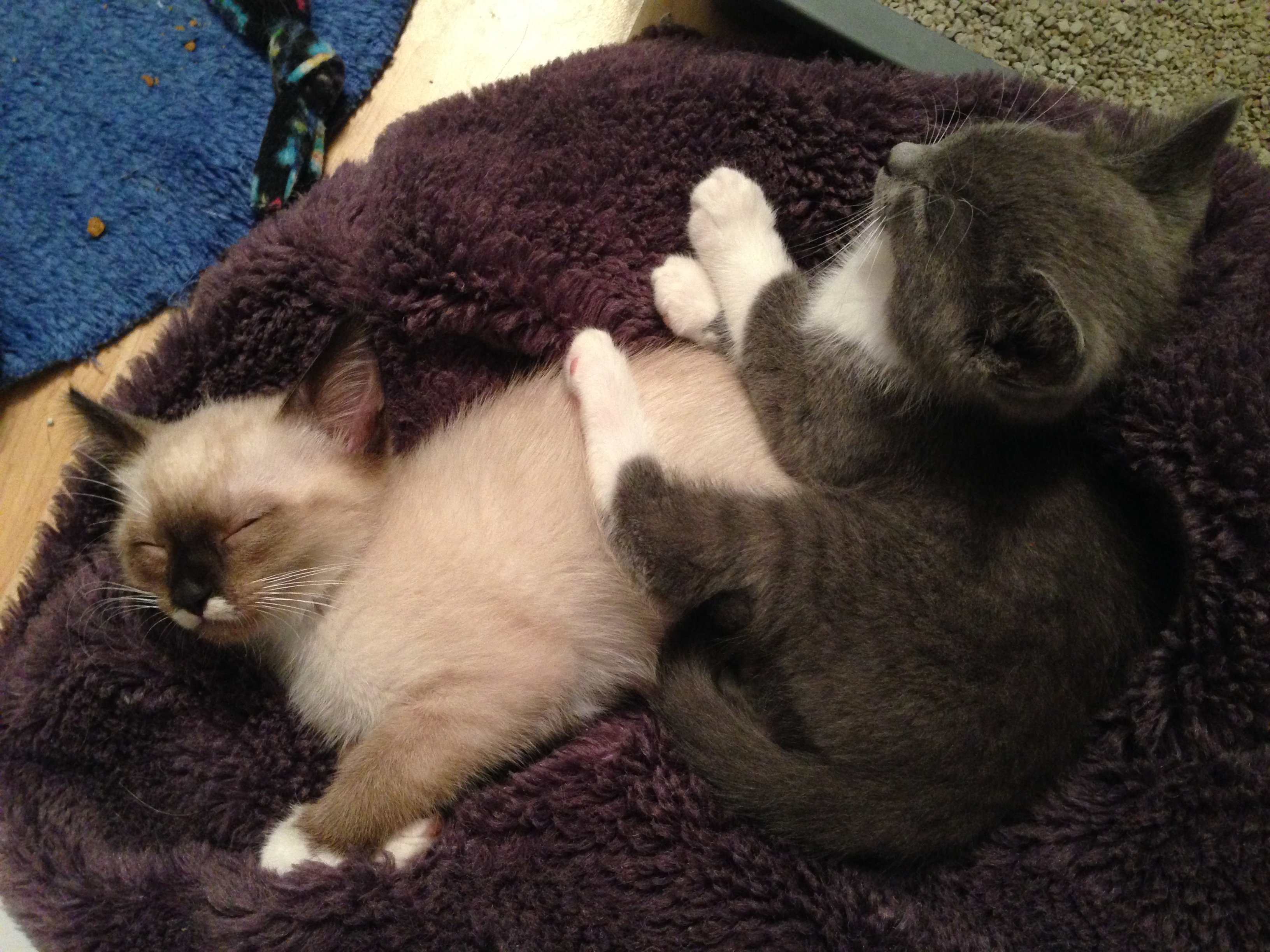
These kittens have each other to help them cope with the stress of a new home, the loss of their mother & litter mates and a buddy to help them adjust to a scary human world.
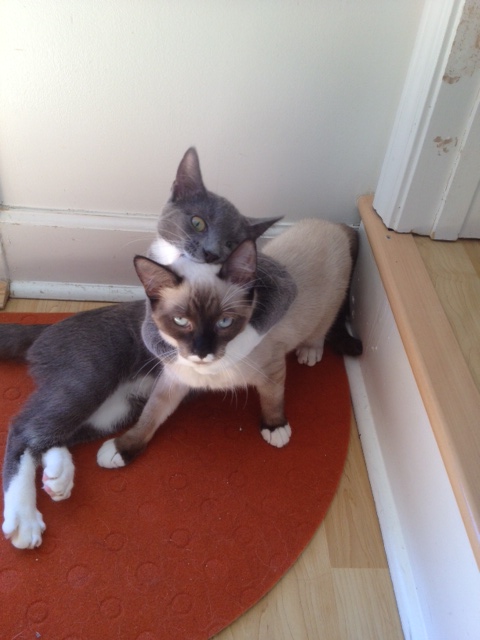
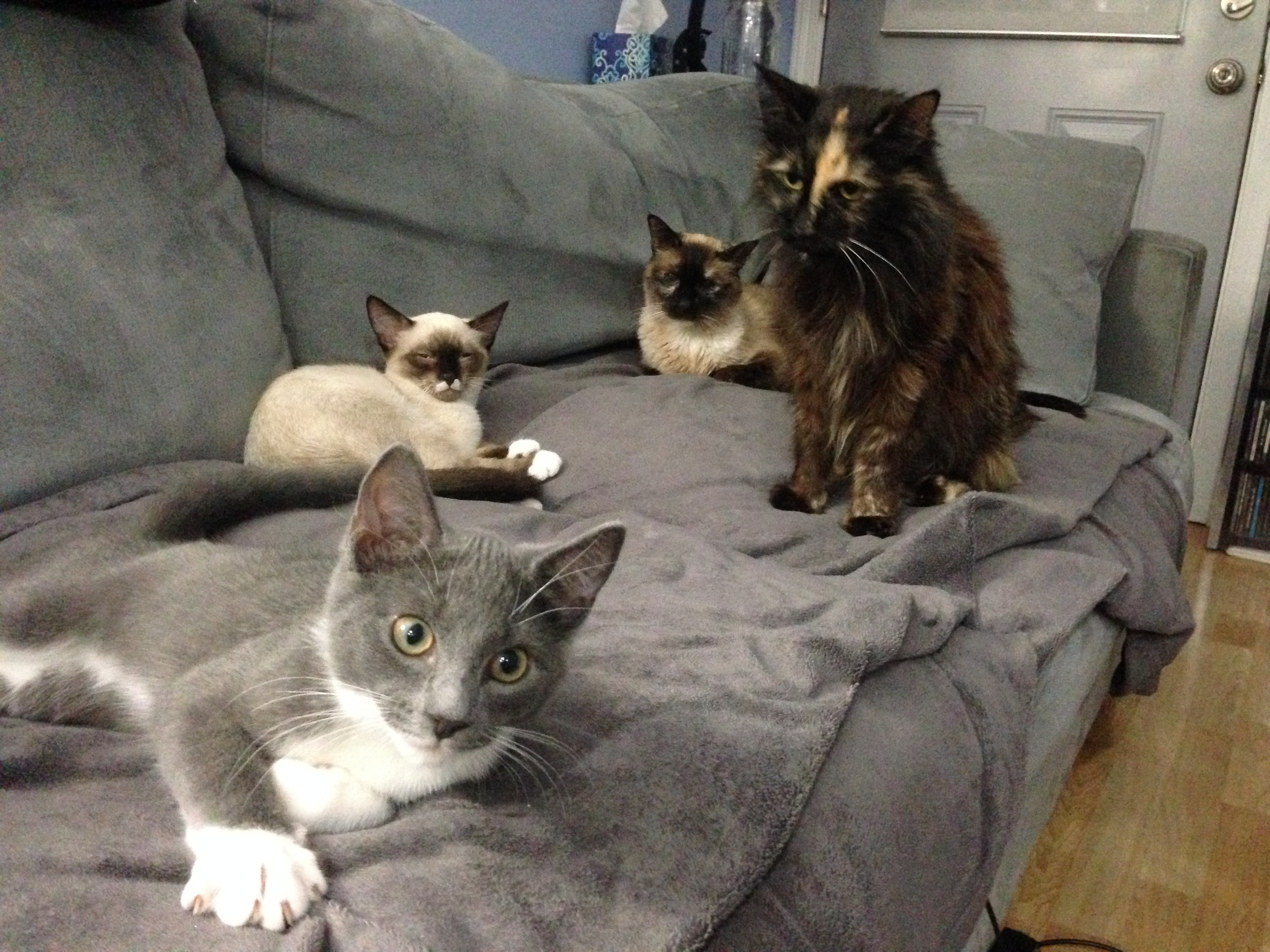
Kittens raised in pairs are more socially normal, more easily introduced to other cats and generally less aggressive towards humans (do not attack hands etc, unless taught to do so).
Often, having more than one cat also results in a reduction in destructive behavior. The cats can play rough and tumble with each other, so they spend less time getting into kitchen cabinets or destroying toilet paper. Not to say those things won’t happen — especially with kittens — but they will happen less often than they would with a single kitten who is bored. Kittens adopted together also have an appropriate playmate to teach them the ropes, so they are less likely to exhibit aggressive behaviors such as biting human hands and feet (unless this is encouraged and taught).
Human hands should be reserved for affection. Hunting blows can be practiced on each other or on appropriate toys. No human or dog can teach a cat, “Hey, you just bit too hard. The game is over now.” That is called “bite inhibition,” and only cats can teach other cats this lesson.
Cats learn the majority of their social skills by the time they are nine to 12 weeks of age. During those early weeks, they learn fear, aggression, and basically how to speak cat. If they miss this key window of time with other cats — say, in the case of a bottle-raised kitten or the impulse adoption of a single kitten taken from its littermates at four weeks old — they may not know what to do with their own species as adults.
Poorly socialized cats have “Tarzan Syndrome.” For comparison, imagine raising a child alone in a room, interacting only by passing a food tray under the door, and then sending that kid to college at age 18. Problems would result.) Most cats with Tarzan Syndrome are aggressive toward other cats. They will defend themselves from the cat you are trying to introduce because they never learned to interact with their own species. They instinctively tell the new cat to back off or else!
“But I really only want one…”
If you insist on adopting only one cat, we strongly encourage you to adopt an adult cat who was raised as an only cat and has no interest in living with other cats. These cats can be extremely difficult to adopt out because so many families have multi-cat households.
It is also common for a person to think they want just one cat then realize how amazing cats are and decide to adopt another after a few years. This rarely goes well. In this scenario, it is often best to adopt a pair of kittens. The existing cat may find them less threatening, and if the kittens do end up being rejected, they will still grow up with each other so that they can learn proper social skills, how to play and spar with other cats, etc. This also ensures that the person does not raise yet another poorly socialized only-child cat. We need to break this cycle!
Compatibility Factors
When adding a new cat to a home with existing adult cats, there are several factors to consider. We humans tend to make selfish decisions without thinking of the repercussions, and adopting pets is no exception. It is important to try to maximize compatibility.
If, for example, you have a 15-year-old cat, you should not adopt a single 6-week-old kitten. Nothing could be worse! That kitten will get bigger and want to play and roughhouse. An arthritic, geriatric cat is not an evenly matched playmate. Over time, the kitten will get more and more frustrated and before you know it, there will be a full-on aggression problem. The older cat will run away, which simply evokes the kitten’s prey drive, making it seem like a game. After all, when caught, the senior kitty probably struggles and screams just like real prey.
Many people have seen a puppy perk up a senior dog and give them new life, but cats are not dogs and this is not the case with this species. In fact, it’s just the opposite; the stress of a new kitten can affect a senior’s quality of life to the extent that we can lose them prematurely to medical problems and disease.
If you have a household of healthy adult cats, the world is your oyster — within the realm of compatibility, of course. The key is to adopt cats of similar activity levels and then to introduce them slowly and positively.
A few additional facts to keep in mind: Many male cats like to engage in adolescent play behaviors well into their teens. Females, on the other hand, become much less interested in physical play once they reach social maturity at about two years of age. They still hunt and engage with toys (solo object play) but are not as interested in wrestling, though there are exceptions. Cats’ social structure is largely matriarchal, meaning that a female often rules the roost. If you end up with a house full of females, you may have a lot of vying for top-cat position. If you have a cat with a very assertive personality, it may be best to introduce an easy-going, well-socialized male who gets along with everyone.
A Lifetime Commitment
Just remember: Adoption is a lifetime commitment and cats can live well into their late teens and even into their twenties. Be committed to making it work and seek advice from your veterinarian and/or local behaviorist if you experience challenges integrating a newcomer.

![[001144] - Copy Unrelated males in a three-way cuddlefest.](https://www.fundamentallyfeline.com/wp-content/uploads/001144-Copy-1.jpg)
